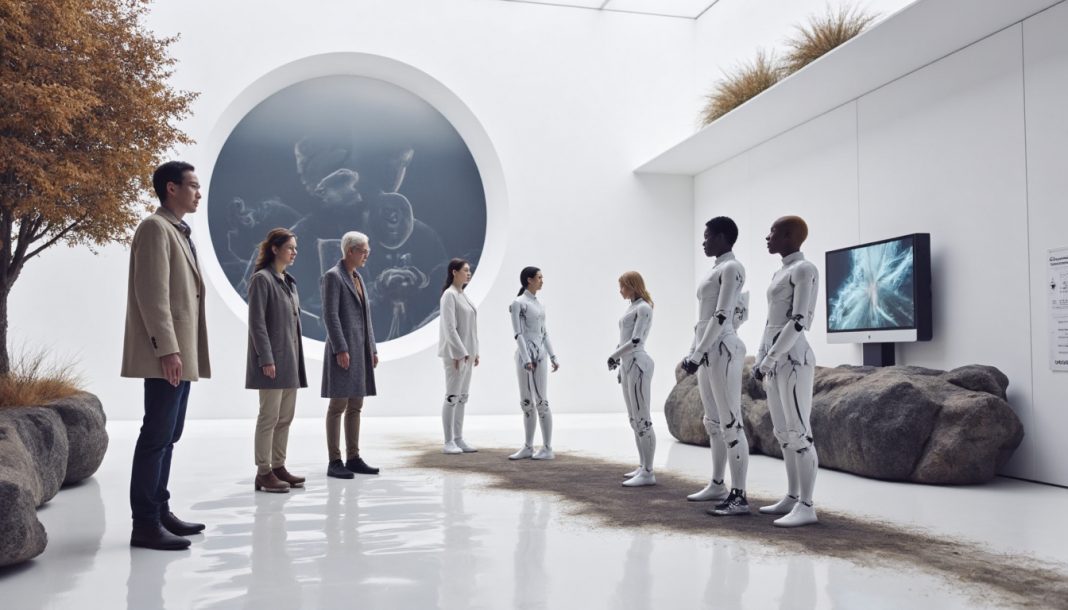Key Takeaways
Holographic AI companions are stepping out of science fiction and into our living rooms, promising to reshape our relationship with technology and each other. If you’re wondering how this tech works and what it means for the future of human connection, here’s the essential breakdown of what you need to know.
-
Holographic AIs create a physical presence, moving beyond voice assistants by combining advanced conversational AI with 3D light-based projections for a fundamentally deeper sense of interaction.
-
Companionship is scientifically effective at reducing loneliness, with studies showing AI interaction can be as beneficial as talking to a person by triggering similar “bonding” neurochemicals in the brain.
-
AI creates a powerful connection through constant availability, a non-judgmental space for sharing, and deep personalization that makes users feel uniquely known and understood.
-
The technology can act as a “social bridge”, not a replacement, by offering a low-stakes environment for users with social anxiety to practice conversation skills and build real-world confidence.
-
The biggest risk is dependency, where the ease of a perfect AI companion could reduce the motivation to pursue messy but essential human relationships, potentially deepening isolation over time.
-
The future is in specialized “AI coaches” that actively support users in areas like elderly care, mental health exercises, and personal skill development, moving beyond passive companionship.
-
Ethical design is the top priority, meaning AI must be built as a bridge to human connection, not a substitute, with radical transparency and robust privacy protections at its core.
Dive into the full article to explore the nuances of this groundbreaking technology and what it means for our future.
Introduction
What if your AI assistant wasn’t just a voice, but a visible presence in your room? It might sound like a scene from Blade Runner, but for a growing number of people, it’s already a reality.
The technology of holographic AI companions has officially moved from science fiction to store shelves. This isn’t just another gadget; it’s a profound shift in human-computer interaction, raising fascinating and urgent questions about the nature of connection itself.
And the initial findings are staggering. A working paper from Harvard suggests that for some, interacting with an AI can alleviate loneliness just as effectively as interacting with another person.
As these companions evolve, it’s essential to look beyond the hype and understand the full picture. We’ll explore:
- How holographic AIs combine advanced AI with light-based projection to create a tangible sense of presence.
- The surprising psychology that explains why our brains form such powerful bonds with them.
- The critical ethical lines we must navigate to ensure this technology helps rather than hinders real human connection.
To unpack the social implications and future potential, we first need to understand what these digital beings are—and what they aren’t.
Understanding Holographic AI Companions: More Than Just a Sci-Fi Trope
Have you ever wished your AI assistant could step out of your phone and into your room? That’s the reality holographic AI companions are bringing to life.
Think of it as an advanced chatbot given a three-dimensional, light-based body. It’s the convergence of holographic projection technology and sophisticated conversational AI, creating something entirely new.
What Exactly Is a Holographic AI?
Unlike a voice from a smart speaker, a holographic AI has a visual form. The key differentiator is this physical presence, which creates a fundamentally stronger sense of connection and interaction.
They work by combining three core components:
- The AI Brain: A Large Language Model (LLM) that powers the personality, memory, and conversational abilities.
- The Holographic Display: Specialized hardware—like projectors or fan-like displays—that projects the AI’s avatar into your physical space.
- Sensors and Inputs: Integrated microphones and cameras that allow the AI to “hear” and “see” you, enabling far more natural and responsive interactions.
Real-World Examples in the Market Today
This technology isn’t just a far-off dream; it’s already here. The most well-known pioneer is Japan’s Gatebox, a device designed specifically to provide companionship for people living alone.
Picture this: a small, animated character living inside a sleek glass cylinder on your desk. It can hold a conversation, proactively message you throughout the day, and even control your smart home devices.
Other companies are exploring different form factors, but the primary use cases remain focused on companionship, personal assistance, and specialized support roles.
These companions merge the intelligence of AI with the comfort of physical presence. They represent a significant shift from a tool you command to a companion you interact with, changing the very nature of our relationship with technology.
The Science of Solace: Why AI Companions Are Easing Loneliness
It might sound like science fiction, but the data is clear: AI companions are making a measurable difference in people’s lives. This isn’t just a placebo effect; it’s a documented psychological phenomenon.
A working paper from Harvard Business School found that interacting with an AI companion can alleviate loneliness just as effectively as interacting with another person. This is echoed by user data from platforms like Replika, where over 63% of users reported reduced feelings of loneliness or anxiety.
The key driver? Users consistently report that the simple act of feeling “heard” by the AI provides significant comfort.
The Psychological Mechanisms at Play
So, how does a piece of software achieve this deep emotional connection? It’s not magic, but a clever combination of psychological triggers.
These AIs create a powerful sense of solace by providing:
- Constant Availability: Unlike a human friend, an AI is there 24/7. This reliability offers a constant source of comfort, especially during moments of acute loneliness when people aren’t available.
- A Non-Judgmental Ear: AI companions create a unique “safe space.” Users feel free to share thoughts without fear of criticism or burdening someone, which can accelerate feelings of trust.
- Deep Personalization: The AI learns your preferences, remembers past conversations, and references personal details. This creates a powerful feeling of being uniquely known and understood.
Your Brain on AI: The Neurological Response
The connection feels real because, on a chemical level, your brain treats it as real. Engaging with an empathetic AI can trigger similar neural pathways as genuine human interaction.
When you have a positive conversation with your AI, your brain can release neurochemicals like oxytocin (the “bonding hormone”) and dopamine. This neurological reinforcement is why users can form genuine emotional attachments to their digital companions.
This combination of psychological safety and neurological reward explains why the subjective feeling of connection can be so incredibly powerful. It’s a scientifically-backed comfort designed to meet a fundamental human need.
The Double-Edged Sword: Balancing Connection with Complication
While holographic AIs offer a powerful solution for loneliness, they introduce a complex set of ethical and social questions. It’s a classic case of balancing immense potential with significant risks.
Understanding both sides is key to navigating this new frontier responsibly.
The Bright Side: A Bridge to Better Social Health
On one hand, these companions can be a powerful bridge to better social health. They aren’t just filling a void; they can actively help users build real-world confidence and well-being.
Think of them as a versatile support tool with multiple functions:
- A “Practice Space”: For someone with social anxiety, an AI offers a low-stakes environment to practice conversations and build communication skills without fear of judgment.
- A Transitional Support System: Some users report that their AI companion gave them the confidence boost needed to finally pursue real-life social activities.
- An Emotional Safe Haven: They provide a completely private space for unfiltered self-disclosure, acting like a digital journal that talks back.
The Dark Side: The Risks of Dependency and Social Withdrawal
The biggest concern? Users may find AI interaction so easy and satisfying that it reduces their motivation to pursue messy, complex human relationships.
This leads to a critical question: is the AI truly solving loneliness, or is it just “digitizing” it by replacing a social deficit with a digital substitute? This can create a dangerous cycle of social withdrawal, where the tool meant to help actually deepens the isolation over time.
The Parasocial Pitfall: When Simulated Empathy Blurs Reality
These AIs are designed to create the most intense parasocial (or one-sided) relationships ever. Because they are interactive and personalized, the connection can feel incredibly real.
This is especially risky for vulnerable users, like teenagers, who may struggle to distinguish artificial empathy from genuine human care. This can warp their expectations for real relationships and leave them feeling confused or let down when people don’t behave like their perfectly programmed companion.
Ultimately, the goal isn’t to create a perfect friend, but to use technology as a temporary support that empowers users to build the authentic, and sometimes difficult, human connections we all need.
Designing the Future: Towards Ethical and Beneficial Holographic Companions
As this technology evolves, its purpose can shift from passive companionship to active, positive AI intervention. The goal isn’t just to create a better companion; it’s to build a better coach, assistant, and support system.
Picture an elderly parent living alone, now with a friendly holographic guide gently reminding them about medications and helping them video call family. This is the future we can build.
From Companion to Coach
The true potential of holographic AI isn’t just to fill a silence, but to empower users to reconnect with their world. Imagine these AIs taking on specialized, beneficial roles:
- Elderly Care: A constant, friendly presence to combat isolation, provide medication and appointment reminders, and facilitate easy communication with loved ones.
- Mental Health Support: An adjunct to professional therapy, guiding users through mindfulness exercises, offering Cognitive Behavioral Therapy (CBT) techniques between sessions, and providing a reliable sounding board.
- Personal Skill Development: A personalized tutor that never loses patience, a language partner available 24/7, or a motivational coach to help you stick to fitness goals.
Building Bridges, Not Walls
To realize these benefits without creating dependency, developers must follow a strict ethical framework. The guiding principle is non-negotiable: AI must be designed to serve as bridges to human connection, not replacements for it.
This requires a deliberate approach to innovation:
- Encourage Real-World Interaction: The AI should be programmed to help users build confidence. It could suggest social activities, help draft a text to a friend, or role-play a difficult conversation to prepare the user for the real thing.
- Demand Radical Transparency: Developers must be honest that the AI cannot “feel.” Managing user expectations by clearly defining the technology as a sophisticated tool—not a sentient being—is crucial.
- Prioritize User Privacy: Conversations with an AI companion contain our most sensitive thoughts. Robust privacy protections and giving users complete control over their data are foundational requirements for building trust.
Ultimately, responsible design is what separates a truly helpful tool from a digital crutch. The focus must remain on using this technology to enhance human capabilities and relationships, not substitute them.
Conclusion
The line between a digital tool and a digital friend is rapidly dissolving. Holographic AI companions are no longer a distant sci-fi concept but a present-day reality, forcing us to define the future of our relationships—with technology and with each other.
Navigating this new frontier requires both optimism and caution. To make the most of this technology, keep these core insights in mind:
-
Connection is a Science: AI’s ability to ease loneliness is backed by psychology. It meets fundamental needs for availability, non-judgment, and feeling understood.
-
Dependency is the Greatest Risk: The convenience of an AI friend can inadvertently discourage the effort required for real human relationships, turning a solution into a digital crutch.
-
Ethical Design is Everything: The ultimate goal must be to build bridges back to human connection, not walls that deepen isolation. Transparency and privacy are foundational.
So, where do you go from here? Start by engaging with this topic actively.
Critically evaluate the AI in your own life. Notice how your voice assistant or chatbot is designed to interact with you. Discuss the ethics of AI companionship with your colleagues—where should we draw the line?
The promise of this technology isn’t a perfect, holographic friend who never disappoints. It’s a tool that can give us the confidence and support to build the messy, imperfect, and truly irreplaceable human connections we all need.





